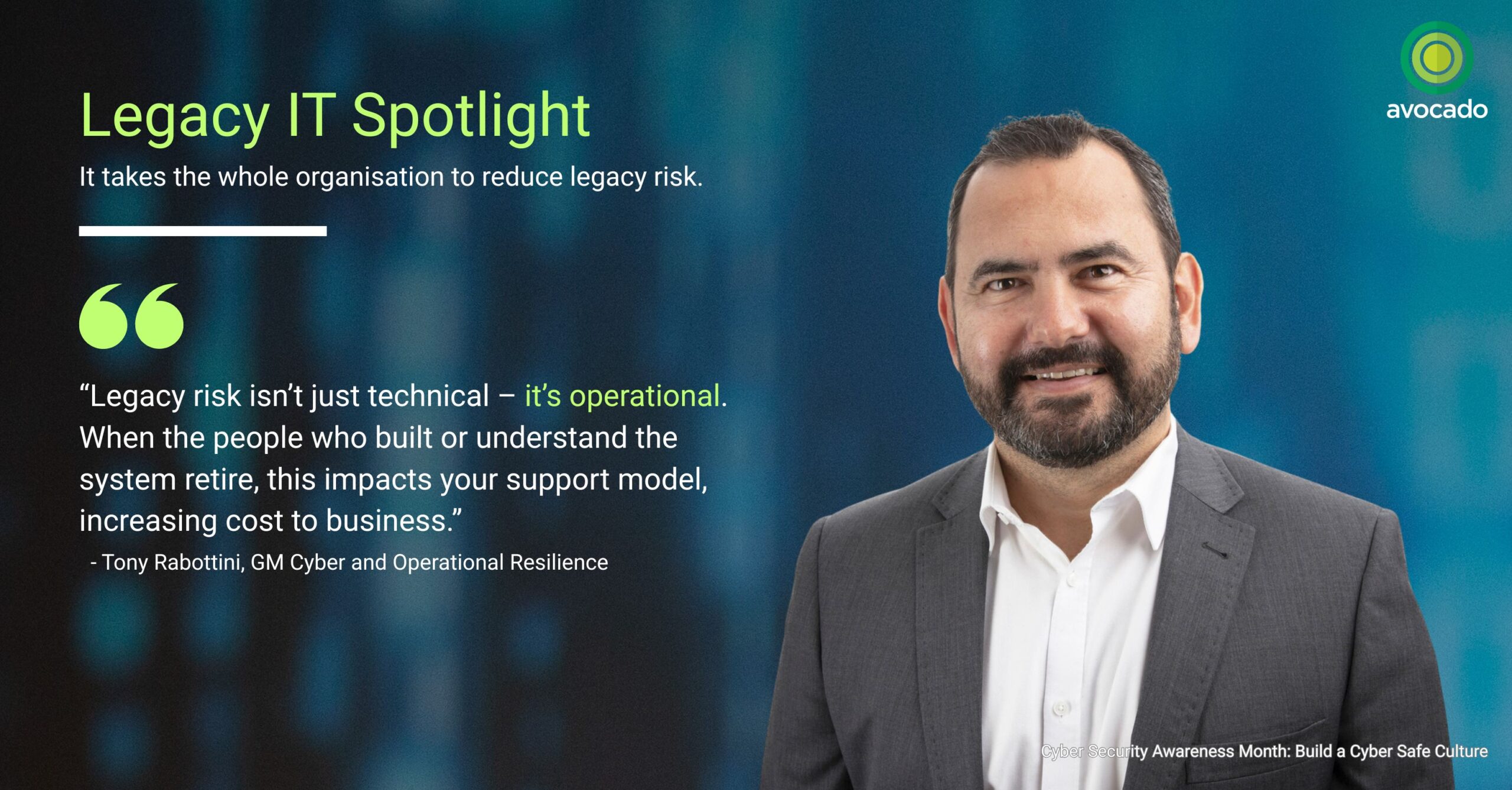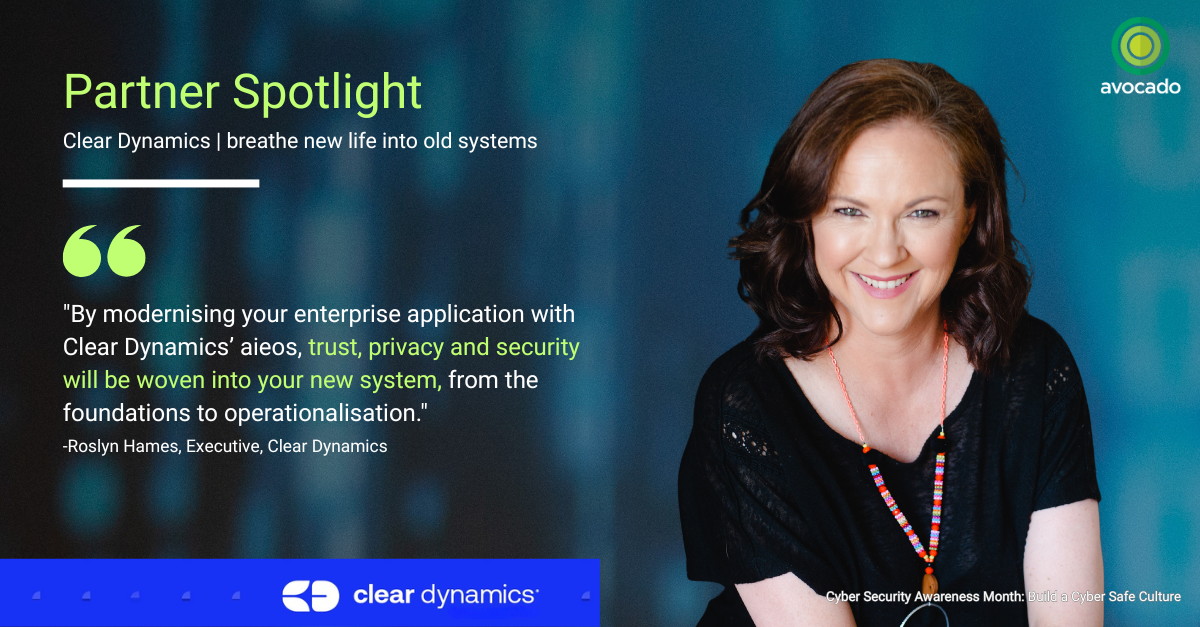Legacy IT and cyber risk: When to modernise, when to mitigate.
Legacy IT is a cyber risk magnet. Learn how to mitigate exposure, monitor smarter, and modernise safely with Avocado’s three-lens approach.
Legacy IT – end-of-life or out-of-support hardware, software, or protocols – remains one of the most common entry points for attackers, according to the Australian Cyber Security Centre.
While full replacement is ideal, it’s not always immediately feasible. And since all IT eventually becomes legacy, organisations must plan for its retirement early to reduce both risk and cost as part of their IT strategy. In this article GM Cyber and Operational Resilience, Tony Rabottini highlights a holistic approach to minimising exposure and disruption of legacy tech and how to effectively modernise – focused on targeted controls, smart monitoring, and staged replacements.
In this blog – quick links:
- What is legacy IT?
- Why legacy IT increases cyber exposure
- Recognising legacy risk before it’s too late
- Avocado’s three-lens approach to legacy IT.
What is legacy IT?
Legacy doesn’t always mean ancient. Even tools less than a decade old can pose serious risk if they’re no longer supported, can’t be patched, or block your current IT strategy.
You’re likely dealing with legacy tech if:
- It’s out-of-support or end-of-life by the vendor
- It can’t be updated without major cost or downtime
- It creates friction with your security model (e.g. zero trust)
- It blocks other upgrades like cloud migration or OS uplift
- Software that is required to support legacy equipment / hardware.
“Legacy risk isn’t just technical – it’s operational. When the people who built or understand the system retire, this impacts your support model, increasing cost to business.”

Escalate privileges through weak authentication
Exploit missing segmentation to move laterally
Disrupt critical services that rely on outdated components
Use Living-off-the-Land (LOTL) tactics to stay undetected
The business impact? Service outages, data loss, compliance failures, reputational damage – and incident response costs that often dwarf the price of proactive modernisation. Organisations often put off replacing legacy tech because of the cost but replacing it is less expensive than a cyber-attack. According to the Australian Cyber Security Centre Threat Report, in 2023-24, the average self-reported cybercrime cost to a medium business was $97,200 (up 55%) and $202,700 (up 219%) for large businesses.
“It’s always cheaper – and safer – to modernise on your own terms rather than rebuild under pressure after an attack. Proactive investment beats reactive recovery every time.”
Recognising legacy risk before it’s too late
Legacy systems aren’t always obvious – such as being flagged in your Configuration Management Data Base (CMDB). They often surface when something breaks, a vendor changes terms, or a transformation project hits a blocker.
Key indicators include:
- No clear owner or support plan
- Manual workarounds or shadow IT
- Apps dependent on outdated browsers or OS
- Inconsistent or minimal logging
For example, we recently covered this in the context of securing code repositories under ACSC’s high alert, where unsupported platforms and delays in uplifting to Windows 11 were flagged as serious gaps. Legacy blockers like these often fly under the radar – until a compliance audit or breach brings them front and centre.
If a system no longer delivers business value – or exceeds your acceptable risk threshold – it’s a liability. When replacement isn’t practical, reduce exposure with targeted controls. Segment networks, harden configurations, enable detailed logging, and restrict access. Even simple steps – like enforcing multi-factor authentication or disabling unused services – can materially lower risk. Ongoing communication with vendors to stay informed about residual threats is also important.
“Legacy risk doesn’t always wear a label. It hides in forgotten systems, outdated dependencies and workarounds no one wants to touch—until they break.”
Avocado’s three-lens approach to legacy IT – Mitigate, Monitor and modernise.
At Avocado, we believe that legacy systems need more than one solution. Our approach is built around three lenses: reduce today’s risk, monitor what you can’t replace right away, and modernise safely when the time is right:
1. Start with Strong Foundations
2. Monitor to detect early and limit impact
3. Replace safely, in stages
1. Start with strong foundations
Begin by reviewing your current environment. Build a complete asset register, understand dependencies, and classify systems by criticality. Identify where legacy exposure intersects with business operations.
From there, apply targeted hardening:
- Enforce MFA and least-privilege access
- Segment networks to contain lateral movement
- Reduce application attack surface by disabling legacy protocols and scripts
- Enable key logs for authentication, admin actions and endpoints
- Restrict access through change windows and tighter controls.
This lays the groundwork for effective monitoring and smoother migrations down the line.
2. Monitor to detect early and limit impact
When modernisation takes time, monitoring fills the gap, giving you early warning signals across legacy and modern systems alike.
For legacy environments using a layered approach can be a reliable solution. This includes:
- Log monitoring to detect unauthorised access or anomalies – turn on/forward critical logs (auth, endpoint, network, app, admin actions); raise retention to investigation-worthy levels.
- Infrastructure observability to track availability, performance and resource pressure
- Endpoint and integration point monitoring to surface misconfigurations or risky behaviours
- End-user experience monitoring to understand impact and catch degradation early.
With platforms like Dynatrace and Splunk, you gain full-stack visibility, even into outdated tiers buried behind modern apps. These tools use automation and AI-powered analysis to quickly identify what changed, where it happened, and who’s affected – reducing mean time to detect (MTTD) and respond (MTTR). Read a case study here.
Pair this with Identity Security platforms like CyberArk to tighten endpoint security. By removing local admin rights, enforcing least privilege, and restricting high-risk behaviours through application control, you reduce the pathways attackers rely on – especially in unpatchable environments.
Together, these platforms don’t just monitor, they give you actionable insights that help prevent small legacy quirks from becoming major incidents.
3. Replace safely, in stages
Stakeholders worry about cost, disruption and time-to-value. Yet, delay only raises the bill: the people who know the old stack are retiring, technical debt compounds, and legacy cements itself in operations. The good news – thanks to new tech, while yesterday’s migrations were painstaking and failure-prone; today’s automation and templates make them predictable.
When modernisation is viable, Avocado partners with Clear Dynamics to replace legacy systems incrementally – without disruption. This solution is perfect for organisations weighed down by complex legacy systems, spreadsheet-driven processes and weak integrations.
Using aieos™ and Clone2Cloud, we map and regenerate legacy logic and data into modern, cloud-native platforms. Migrations are automated, reconciled, and staged, preserving business rules, and ensuring no data loss.
Roslyn Hames, Executive at Clear Dynamics says Clear Dynamics builds in trust, privacy, and security from start to finish. She says:
“By modernising your enterprise application with Clear Dynamics’ aieos, trust, privacy and security will be woven into your new system, from the foundations to operationalisation.”

At Avocado, we start with a targeted MVP to demonstrate value, then scale using reusable patterns and secure foundations. The result is a platform that’s adaptable, supportable and aligned to your broader strategy.
How Avocado helps you move forward
Fix what you can. Watch what you can’t. Replace with confidence. Legacy IT doesn’t need to be a blocker forever. Whether you’re in a highly regulated industry or a fast-scaling organisation, Avocado helps reduce risk today and modernise for tomorrow through:
- Security reviews identify and prioritise legacy exposure
- Hardening playbooks reduce attack surface fast
- Monitoring platforms provide early warning signals
- Moedrnising IT enables safe, automated migration
- Stakeholder support helps justify funding and manage change.
If you can’t replace it today, monitor and control the risk now.
If you’re ready to act, modernise with confidence.
Avocado helps you do both. Contact us for a free consultation.
Don't let legacy linger
Legacy IT isn’t just technical debt – it’s active risk. Contact us for a free consultation.










